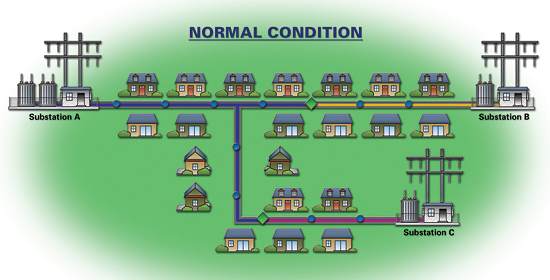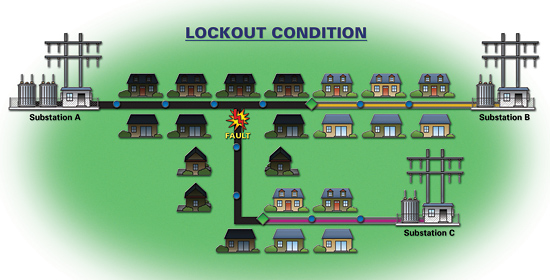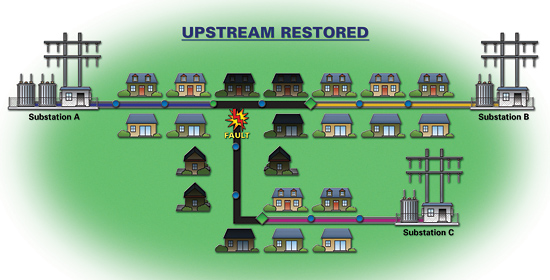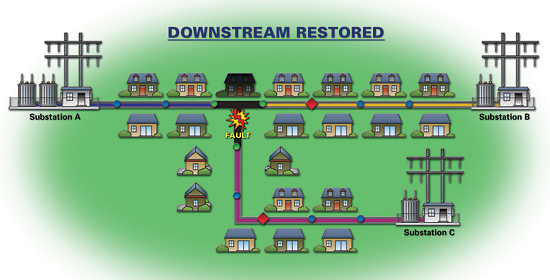With the implementation of its Pullman, Wash., Smart Grid Demonstration Project, Avista stands at the forefront of comprehensive smart grid deployment. The project aims to modernize much of Avista’s Pullman electric distribution system using intelligent devices and two-way communication. As part of the project, Avista is installing a wide-area private wireless broadband network as its communications infrastructure. In addition to distribution automation, the project encompasses advanced metering infrastructure and a customer pilot that will provide customers in-home energy consumption data, establish and test regional demand response signals and help the utility understand customer experience, satisfaction, and program participation.
The project’s goals are to understand the value smart grid technologies can bring to Avista and its customers, as well as the costs of providing those benefits, so that the utility can better analyze costs and benefits of various smart grid applications. In addition to understanding the viability of each service used in the project, Avista seeks to understand how to best expand successful smart grid applications to the rest of the company’s customers.
Avista is an investor-owned utility headquartered in Spokane, Wash. The company provides electricity to about 357,000 customers and natural gas to 317,000 customers. Its service territory spans approximately 30,000 square miles in eastern Washington, northern Idaho and parts of southern and eastern Oregon.
Avista’s Pullman Smart Grid Demonstration Project is part of the Pacific Northwest Smart Grid Demonstration Project, a project led by Battelle under the auspices of the U.S. Department of Energy (DOE). The project involves 11 utilities, the Bonneville Power Administration, along with the University of Washington, Washington State University, and five technology partners. The project has a budget of $178 million split between the DOE and project participants. The project aims to verify the viability of smart grid technology and quantify smart grid costs and benefits.
Under this umbrella, Avista is implementing the Pullman Smart Grid Demonstration Project in cooperation with local cost share partners Itron, Washington State University (WSU), Hewlett Packard and Spirae. The total cost of the project is expected to be $38 million. Avista is contributing $14.9 million, Avista’s cost share partners an aggregate of $4 million and the DOE is supplying a matching grant of $19 million. Other partners include vendors and contractors such as Scope, Efacec Advanced Control Systems and Schweitzer Engineering Labs.
Avista selected Pullman for the Smart Grid Demonstration Project because it is the right size and offers a good mix of industrial, commercial and residential customers. Pullman is also the home of WSU, with its acclaimed Power Engineering program. WSU’s current research areas include smart home, wind integration, electrical grid security and electric grid stability. The city is also home to Schweitzer Engineering Labs, a leading vendor of protective equipment. An important aspect of Schweitzer’s and WSU’s participation is that both have small scale electric generation capability, critical for testing distributed generation integration and net metering.
Avista’s goals for the Pullman Smart Grid Demonstration Project are to demonstrate and evaluate smart grid applications and technologies; show how the electric grid can react to sudden changes in power supply and demand; and help prepare Avista and its customers for the modernization of the electrical grid. The company will meet these goals by:
- Upgrading electrical facilities and automating the electrical distribution grid to support intelligent devices and two-way communication between the utility and all parts of the system.
- Demonstrating technologies and tools, including advanced metering, in-home devices and web tools, to understand ways to enable customers to actively monitor and better manage their energy usage.
Potential benefits of the project include:
- Less waste from lost power as it moves through the transmission and distribution system helps Avista reduce operating costs and conserves power to help meet demand.
- Distribution technology can automatically detect and isolate an outage, saving time and reducing outage frequency and length for customers.
- Partnering with customers to provide them with better information about their energy usage gives customers tools to use energy more efficiently.
Distribution Automation
Recently, advances in communication technologies have enabled the smart grid vision of distribution automation. Devices such as capacitor banks, switches, reclosers, sectionalizers and transformers can be actively monitored and operated remotely from substations and in utilities’ data centers.
The distribution portion of the Pullman Smart Grid Demonstration Project encompasses 13 distribution feeders. Along these feeders, Avista has installed 34 reclosers and 30 capacitor banks. With these devices, Avista can quickly and automatically pinpoint distribution network faults, reducing the number and frequency of outages and improving system reliability. They also enable the utility to reduce energy losses, lower energy consumption and better integrate distributed renewable generation resources.
In addition, Avista is installing smart transformers in Pullman. These devices provide integrated telemetry, including voltage and current measurement, as well as thermocouples to determine internal temperature. Avista will use the telemetry data to perform conservation voltage reduction calculations for automated Volt/VAR management and to proactively determine when transformers need to be replaced. And, when coupled with the project’s advanced metering infrastructure (AMI) deployment (see below), smart transformers could help the utility detect electricity theft by comparing the amount of power passing through a transformer to the aggregate power consumption measured by the smart meters downstream from that transformer.
Increased Reliability
The smart reclosers automatically reroute power to minimize the effect of an outage. They support fault isolation to enable upstream and downstream restoration of electricity with no operator intervention. This capability can increase reliability by reducing the length of outages from hours to minutes.
The example below demonstrates how distribution automation can quickly restore power in the event of a fault. During normal operation, the neighborhood has three distribution circuits, one from each of three substations, as shown in Figure 1.

Figure 1
In Figure 2, a fault occurs, perhaps because a car has hit a utility pole. The fault causes all homes served by Substation A to lose power.

Figure 2
In Figure 3, service between the fault region and Substation A is restored by automatically closing the reclosers upstream from the fault.

Figure 3
In Figure 4, service between the fault region and Substations B and C is restored by closing the reclosers serving as tie points between the distribution circuits and closing the reclosers between the tie points and the fault. Now the outage is contained to the area between the site of the accident and the nearest recloser in the direction of each substation.

Figure 4
Without smart grid technology on the distribution system, isolating the fault is a manual process. Manipulating the reclosers requires truck rolls, which can take hours. With smart technology, the process can be computerized and automated – requiring little or no manual intervention – and could be accomplished in minutes.
Increased Efficiency, Reduced Power Consumption
In addition to increased reliability, the Pullman Smart Grid Demonstration Project promises increased efficiency and reduced power consumption. The project will use active Volt/VAR management and conservation voltage reduction (CVR) to reduce system losses that occur through distribution, saving energy and reducing carbon emissions. In addition to reducing carbon emissions from power generation, the Pullman Smart Grid Demonstration Project could enable Avista to reduce emissions and fuel consumption by reducing vehicle use for switching, outage isolation and service restoration.
Advanced Metering Infrastructure Deployment
Avista electric and gas customers in Pullman, including residential, commercial and industrial customers, have been outfitted with advanced metering. In total, approximately 13,000 electric and 5,000 natural gas meters were upgraded to advanced meters in spring and summer 2011.
Advanced metering can offer benefits to Avista and its customers alike. The utility could decrease labor costs by reducing the number of employees who must travel into the field to manually read meters.
For new tenants and homeowners, the process of transferring utility service from the previous occupant will become faster because Avista will be able to conduct the required meter reading from a central location rather than having to schedule a truck roll to perform a manual, in-field reading. Service connection and disconnection can also be accomplished from a central location, without a truck roll.
In the future, the advanced metering infrastructure would also assist Avista with outage management. The meters could notify Avista when power to individual homes and businesses is interrupted. Proactive notification can enable the utility to promptly detect outages and accurately determine their scope. As power is reestablished, the meters would also notify Avista of restoration at individual locations, allowing the utility to ensure that power is available to all customers without remaining isolated pockets of outage.
The advanced meter technology can also enable Avista to provide information to customers about their ongoing energy usage. The information collected by the meters and made available to customers, using tools such as a secure web portal, can include interval usage data. This information can allow customers to actively monitor and manage their energy usage and make more informed decisions about choices that drive their costs.
The concept behind CVR is simple – reduce power consumption by slightly reducing voltage. Implementation, however, is complex.
Nominal 120V power has a +/- 5% tolerance, i.e., as long as the actual voltage delivered to the customer is between 114V and 126V, the power is considered to be within specification. In practice, most utilities transmit power from substations at the high end of this range to ensure that, after distribution line loss, customers at the far end of the distribution feeder receive electric service that conforms to the minimum voltage limit. The net effect is that customers can receive higher than necessary voltage and, as a result, consume unneeded power.
Using CVR, utilities lower the voltage of the electricity they transmit from their substations to conserve power. While CVR can reduce power consumption, utilities must ensure that, at all points along the distribution feeder, the supplied power remains within the specified voltage range at all times.
Utilities can make certain that voltage remains within specification throughout their distribution feeders by installing voltage measurement points. These measurement points can be remotely monitored via a wireless network. By monitoring the voltage along feeders, the utility can implement a feedback system that enables conservation voltage reduction while ensuring that customers at the far end of feeders receive voltage that conforms to specification.
Customer Pilot
The customer pilot enables customers to actively participate in the Pullman Smart Grid Demonstration Project. Plans for this voluntary pilot project include providing a home area network (HAN) and smart in-home devices such as thermostats, so customers can view and manage their energy usage in the home at the time of use. This should enable customers to detect spikes in energy use almost immediately.
Avista plans to recruit up to 1,500 volunteers to participate in this program. Another aspect of the pilot is demand response. When demand begins to outstrip supply, the demand response system can adjust smart thermostats in the homes of pilot volunteers to conserve power and better balance demand with supply. Customers can override settings or opt out at any time.
The demand response portion of the Pullman Smart Grid Demonstration Project is expected to show how the electric grid can react to sudden changes in power supply and demand. This is important for making the grid renewables-ready, demonstrating how it can adjust to intermittent renewable power sources such as wind and solar.
Pullman Smart Grid Demonstration
Project Communication Requirements
In choosing a network for the project, Avista conducted a multi-dimensional technology analysis. The technologies considered, the choices that Avista made, and the factors that led them to make those choices are summarized in the following table.

Based on these criteria, Avista elected to deploy a wide-area private wireless broadband network based on technology from Tropos Networks that is embedded in Itron AMI collectors and routers. The network’s capabilities closely match Avista’s requirements in each technology dimension considered.
The demand response functionality of Avista’s customer pilot uses the capabilities of a transactive control system located at Battelle. This system continually monitors electricity supply and demand, issuing a transactive signal whose value depends on the supply/demand balance.
During times when demand outpaces supply, for example when energy use is low and intermittent renewable power sources are on line, the value of the transactive signal is low. When demand outstrips supply because of, say, a spike in usage or a drop in supply due to, for example, wind-generated power going off line on a calm day, the value of the transactive signal increases. The transactive signal is analogous to price in a product market, which will increase when demand begins to exceed supply.
In the case of Avista’s pilot project, when the transactive signal rises above a programmable threshold, the demand response system would communicate with the smart thermostats in homes participating in pilot. The demand response system would adjust the smart thermostats to conserve power, better balancing supply and demand.
Pullman’s Private Wireless
Broadband Network
Avista’s network provides a high performance wireless distribution area network for smart grid communications. Based on open industry standards, it enables real time communications between the utility’s data center, substation controllers, distribution automation devices, and AMI collectors and meters.
Avista’s network provides a common communications infrastructure for all of the Pullman Smart Grid Demonstration Project’s initial applications. It also offers the capacity, security, reliability, scalability, low latency and multi-use feature set needed to enable Avista to deploy additional applications, such as SCADA, mobile workforce automation and substation security, on the network in the future.
The network was constructed using wireless broadband routers mounted on utility pole horizontal mast arms and overhead neutral conductors throughout the coverage area. The routers provide wired 10/100BASE-T Ethernet connectivity to smart grid devices co-located with the routers and a communications path to Avista’s core fiber optic network, connecting at the utility’s substations.
Using the network and sophisticated head-end system software, Avista can manage the distribution system and provide both automated and operator initiated responses to faults in distribution circuits. The combination of intelligent devices in the field, a high-performance communications network and head-end software enables Avista’s Pullman Smart Grid Demonstration Project to deliver increased efficiency and reliability.
The Road Forward
With the Pullman Smart Grid Demonstration Project, Avista aims to improve system reliability, reduce energy losses, lower system costs, reduce the frequency and length of customer outages and learn more about integrating distributed renewable generation resources.
The project includes advanced metering infrastructure and a customer pilot in addition to distribution automation. The project should provide Avista with data the company needs to better analyze costs and benefits of various smart grid applications. In addition to understanding the viability of each service in the demonstration project, Avista seeks to understand how to best expand successful smart grid applications to the rest of the company’s customers.
Avista is using a wireless broadband network as the communications foundation. With the network providing the communications infrastructure, Avista is evaluating the deployment of many smart grid applications, including AMI with interval metering, distribution automation, home area networks, demand response, outage management, distributed generation integration, plug-in hybrid electric vehicle support, substation security and more on a single secure, reliable and scalable broadband wireless network.
About the Authors
 Heather Rosentrater joined Avista in 1996 as a student while studying Electrical Engineering in college. Upon receiving her bachelor’s degree from Gonzaga University in 1999 and was hired as an engineer at Avista. Rosentrater has held several energy delivery engineering positions. In 2009 she became the Director of Asset Management and Process Improvement. In her current role she has direct oversight of Avista’s two Smart Grid stimulus projects, which have a combined project value over $80 million and project schedule of five years. She is a registered Professional Engineer, an Adjunct Professor at Gonzaga University and serves on the Advisory Council for Washington State University’s School of Electrical Engineering and Computer Science.
Heather Rosentrater joined Avista in 1996 as a student while studying Electrical Engineering in college. Upon receiving her bachelor’s degree from Gonzaga University in 1999 and was hired as an engineer at Avista. Rosentrater has held several energy delivery engineering positions. In 2009 she became the Director of Asset Management and Process Improvement. In her current role she has direct oversight of Avista’s two Smart Grid stimulus projects, which have a combined project value over $80 million and project schedule of five years. She is a registered Professional Engineer, an Adjunct Professor at Gonzaga University and serves on the Advisory Council for Washington State University’s School of Electrical Engineering and Computer Science.
 Narasimha Chari is the co-founder and Chief Technology Officer for Tropos Networks, where he was responsible for developing Tropos Networks’ core intellectual property, including the design and development of the company’s wireless networking and routing protocols. Throughout his career Mr. Chari has performed research, published papers and disclosed patents in a variety of areas of mathematics, physics and wireless networking. Among other honors, he was recognized by MIT Technology Review magazine in 2005 as one of the Top 35 Innovators under the age of 35. He received his BS in Mathematics and Economics from the California Institute of Technology and an AM in Physics from Harvard University.
Narasimha Chari is the co-founder and Chief Technology Officer for Tropos Networks, where he was responsible for developing Tropos Networks’ core intellectual property, including the design and development of the company’s wireless networking and routing protocols. Throughout his career Mr. Chari has performed research, published papers and disclosed patents in a variety of areas of mathematics, physics and wireless networking. Among other honors, he was recognized by MIT Technology Review magazine in 2005 as one of the Top 35 Innovators under the age of 35. He received his BS in Mathematics and Economics from the California Institute of Technology and an AM in Physics from Harvard University.







